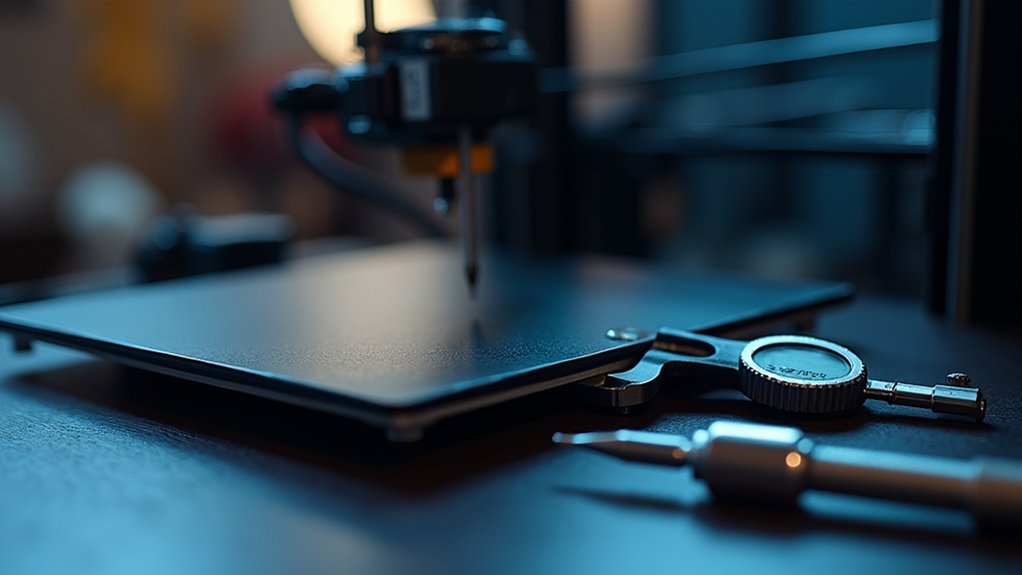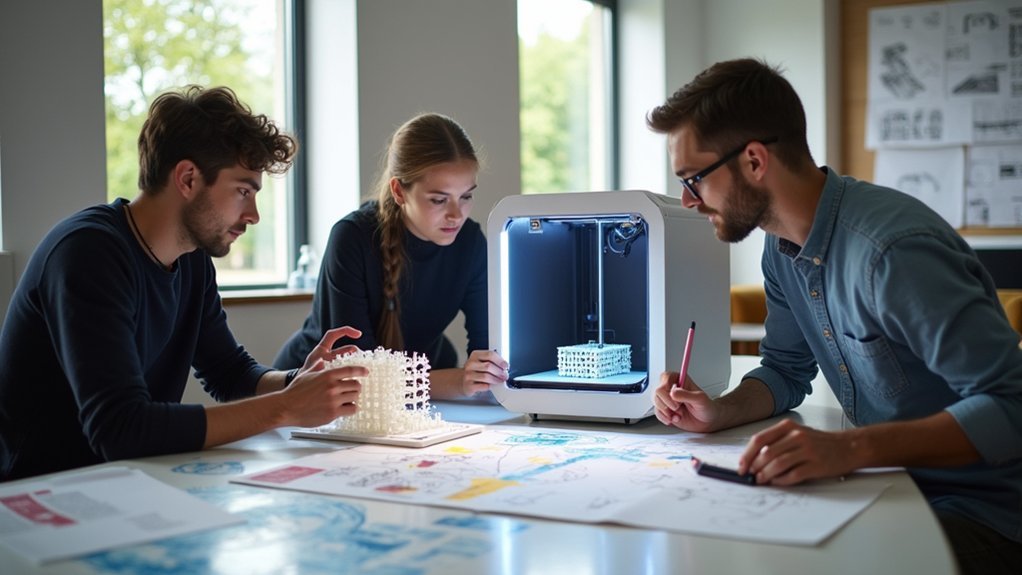You’ll achieve perfect Creality Ender bed leveling by mastering the paper method with preheated nozzle and bed, then automating the process using G29 commands for multi-point probing. Focus on corner adjustments first to establish a solid baseline before checking center points. Upgrade to glass beds for consistent flatness, maintain your adjustment springs with stiffer aftermarket versions, implement mesh bed leveling for detailed surface mapping, and consider adding BLTouch sensors for complete automation. These techniques will reveal your printer’s full potential.
Master the Paper Method for Perfect Nozzle Height

Precision matters when setting your Creality Ender’s nozzle height, and the paper method offers the most reliable approach for beginners and experienced users alike.
The paper method delivers consistent, precise nozzle height calibration for reliable 3D printing results every time.
You’ll need standard printer paper (approximately 0.1mm thick) to gauge proper distance between your nozzle and bed. Start by preheating both nozzle and bed for accurate expansion conditions.
Navigate your nozzle to each corner using the control panel, then slide paper between nozzle and bed. Adjust the corner screws until you feel slight resistance when moving the paper—it shouldn’t tear or move freely.
Repeat this process at all corners and center. Use consistent, gentle movements with the same paper throughout. Clean your nozzle and bed surface beforehand, and don’t over-tighten screws.
Multiple leveling rounds guarantee ideal results. Consider upgrading to a glass bed for improved flatness if your stock bed has significant imperfections that make consistent leveling difficult.
Use G-Code Automation to Speed Up Your Leveling Process
You can eliminate repetitive manual positioning by downloading preset G-code files that automatically move your nozzle to each bed screw location.
Your Ender printer’s automated multi-point probing capabilities let you run thorough bed surveys with a single G29 command instead of checking points individually.
Custom G-code commands allow you to create personalized leveling routines that combine homing, probing, and strategic pauses for the most efficient workflow possible. These automated procedures significantly reduce trial and error during your printer setup process.
Download Preset Position Files
Automating your bed leveling process with preset G-code files transforms a tedious manual task into a streamlined, consistent routine. You’ll save time while reducing positioning errors that commonly occur during manual adjustment.
| G-Code Command | Function | Purpose |
|---|---|---|
| G29 | Initiates probing | Automatically measures bed surface |
| M500 | Saves to EEPROM | Retains leveling data after reboot |
| M420 S1 | Enables compensation | Activates stored leveling corrections |
Download these preset files from community repositories or 3D printing forums. Customize them by editing probe points to match your bed’s dimensions and screw locations. Include M0 or M25 pause commands for manual adjustments during automated sequences. Insert M420 S1 into your slicer’s start G-code to guarantee leveling remains active throughout every print job. Enable the Print Calibration option in your slicer settings to ensure automatic bed leveling activates for each print.
Automated Multi-Point Probing
Multi-point probing takes bed leveling automation several steps further by measuring your print surface at numerous predetermined locations across the entire bed.
You’ll use G28 to home your printer first, establishing a reliable reference point. Then G29 initiates the automated probing sequence, collecting height data from multiple points including corners and center areas.
Your firmware stores this data and compensates for bed irregularities during printing, eliminating manual adjustments and guesswork.
You’ll need to verify your Ender runs Marlin firmware that supports automatic bed leveling commands. Place G29 correctly in your start G-code sequence after homing for ideal results. Use M500 to save the leveling data to EEPROM so it persists between printing sessions.
This method saves significant time compared to manual leveling while providing better consistency across your entire print surface, especially for frequent print jobs.
Custom G-Code Commands
While automated probing handles most leveling tasks, custom G-code commands give you precise control over every aspect of your Ender’s bed leveling process.
Start with `G28` to home all axes, then use `G29` for automatic mesh bed leveling. Include heating commands like `M140` and `M190` to reach proper bed temperature before leveling, accounting for thermal expansion effects.
Create custom scripts that move your nozzle to specific leveling points using `G1` with exact X and Y coordinates.
Add `M0` pause commands at each position, giving you time for manual screw adjustments. When making these adjustments, follow a diagonal pattern similar to tightening car lug nuts for optimal results. Use `G92 E0` to reset extruder position and `M420 S1` to activate mesh compensation during printing.
These sequences streamline your workflow and guarantee consistent leveling results.
Focus on Corner Adjustments Before Center Points
You’ll achieve better bed leveling results by adjusting your printer’s corner points first, since these establish the fundamental plane across your build surface.
Start with the corner priority method to address the most significant height variations before moving inward.
Once you’ve dialed in all four corners, you can then perform center follow-up checks to fine-tune any remaining inconsistencies. This systematic approach ensures a solid first layer foundation that’s critical for successful 3D printing results.
Corner Priority Method
Although many users instinctively want to adjust all bed points simultaneously, the corner priority method proves far more effective by establishing a stable foundation first.
You’ll create a reliable baseline that allows your printer’s mesh bed leveling to compensate for minor surface irregularities between corners.
Here’s how this method benefits your printing:
- Reduces excessive Z-offset corrections during printing by establishing proper nozzle-to-bed distances upfront
- Prevents warped surfaces at print start by creating a stable perimeter frame for firmware algorithms
- Improves first-layer adhesion since nozzle height is optimized at bed edges where print stability begins
- Saves time by avoiding repeated center adjustments that firmware automatically manages through mesh leveling
This foundational approach eliminates most bed-related print failures before they occur. Understanding mesh data helps diagnose print issues and ensures your corner adjustments create the proper foundation for successful prints.
Center Follow-Up Checks
Once you’ve established proper corner adjustments, your center point verification becomes the critical checkpoint that confirms uniform bed leveling across the entire build surface.
You’ll need to wait for the bed to stabilize before measuring the center gap with standard A4 paper. The paper should slide under your nozzle with slight resistance—neither tight nor loose.
Position your nozzle at the exact center using manual controls or G-code commands. Make small incremental screw adjustments to avoid overshooting the proper height.
Different bed materials like glass or added accessories can affect your measurements, so you’ll need to recalibrate accordingly.
Always conduct a final center check after locking all corners in place. Significant discrepancies at the center may indicate a warped bed requiring compensation or replacement.
Upgrade to Glass Beds for Consistent Surface Flatness

When your Creality Ender’s stock bed consistently produces uneven first layers or warped prints, upgrading to a glass bed offers one of the most cost-effective solutions for achieving truly flat printing surfaces.
Glass beds provide exceptional flatness compared to flexible or magnetic alternatives, eliminating warping issues that plague stock surfaces. They’re considerably cheaper than auto-bed leveling sensors, making them an accessible first upgrade.
You’ll appreciate how glass maintains its rigid structure through countless heat cycles while heating up quickly for consistent temperatures. The excellent heat conduction ensures better heat distribution across your entire print surface.
Key benefits include:
- Superior flatness – Glass won’t warp over time like flexible beds
- Easy maintenance – Clean with isopropyl alcohol without damage concerns
- Excellent adhesion – Particularly effective for PLA printing
- Long-term durability – Tempered options resist impacts and daily wear
Generic 235mm x 235mm glass pieces work effectively as budget alternatives to official Creality options.
Maintain Your Adjustment Springs and Hardware
Even with a perfectly flat glass bed, your Creality Ender’s leveling performance depends entirely on the springs and hardware that support it.
You’ll want to inspect your bed springs regularly for compression or weakening, as degraded springs cause inconsistent bed height.
Replace original soft springs with stiffer aftermarket versions to improve stability and maintain leveling over time.
Secure your bed leveling screws with 4mm jam nuts to prevent them from spinning and causing shifts during prints.
Place jam nuts behind mounting points and hold screws steady with pliers while tightening.
You’ll need to remove the leveling knobs first to access the screws properly.
Check hardware tightness regularly and re-level your bed as part of your pre-print routine to maintain consistent print quality.
Always adjust your bed spring tension before starting the actual leveling process to ensure optimal positioning.
Implement Mesh Bed Leveling for Advanced Calibration

While manual corner leveling provides a solid foundation, mesh bed leveling takes your Creality Ender’s calibration to the next level by measuring multiple points across the entire print surface.
While manual leveling builds the foundation, mesh bed leveling elevates your 3D printer’s precision by mapping the entire print surface.
This advanced technique creates a grid (typically 5×5) that maps height variations across your bed, enabling real-time nozzle adjustments during printing.
To implement mesh bed leveling effectively:
- Start with manual leveling – Get your corners roughly level before running the mesh routine
- Follow the interface prompts – The probing process takes several minutes but provides essential data
- Review the mesh values – Check for consistency and identify severely warped areas
- Update your firmware – Newer versions offer improved mesh features and visual feedback
The resulting mesh profile automatically compensates for bed irregularities, ensuring consistent first layers. Remember that periodic recalibration will maintain optimal performance as environmental conditions and bed surfaces change over time.
Add BLTouch Sensors for Automated Bed Leveling
For users seeking complete automation of the bed leveling process, installing a BLTouch sensor eliminates the guesswork and manual adjustments that come with traditional leveling methods.
You’ll need to mount the sensor to your hot end carriage using the included bracket and screws, then route the cable alongside existing wiring with zip ties for protection.
Since Ender 3 and Ender 3 Pro models lack bootloaders, you’ll require an ISP cable and adapter to flash BLTouch-compatible firmware from Creality’s website.
Connect the sensor’s wires to the correct mainboard pins following color codes or markings, and remove the original Z-limit switch wiring to prevent conflicts.
The BLTouch upgrade ensures perfect first layers by automatically compensating for any variations in your print bed surface.
After installation, calibrate your Z-offset by homing, extending the probe, and measuring the distance between nozzle and trigger point for accurate bed detection.
Frequently Asked Questions
How Often Should I Re-Level My Ender Bed During Regular Printing?
You should re-level your bed every few prints when using the same material. Check it immediately when changing filaments, build surfaces, or if you notice poor first layer adhesion.
What Should I Do if My Bed Won’t Stay Level After Adjustments?
Check your V-slot wheels for wear, tighten loose bed mounting hardware, and replace soft springs. Inspect the bed frame for damage and guarantee leveling screws adjust smoothly without binding or slipping.
Can I Level My Bed When It’s Heated or Should It Be Cold?
You should level your bed when it’s heated to printing temperature. Thermal expansion changes bed dimensions slightly, so leveling hot guarantees accurate nozzle-to-bed distance during actual printing conditions.
Why Does My First Layer Still Fail After Successful Bed Leveling?
Your Z-offset might need fine-tuning even after leveling. Check bed cleanliness, first layer speed, nozzle temperature, and flow rate. Dirty surfaces or wrong printing parameters cause failures despite proper leveling.
Should I Level With PLA or ABS Filament Loaded in the Hotend?
You should level with the same filament type you’ll print with. If you’re planning to print PLA, level with PLA loaded. For ABS prints, level with ABS to match thermal conditions.





Leave a Reply